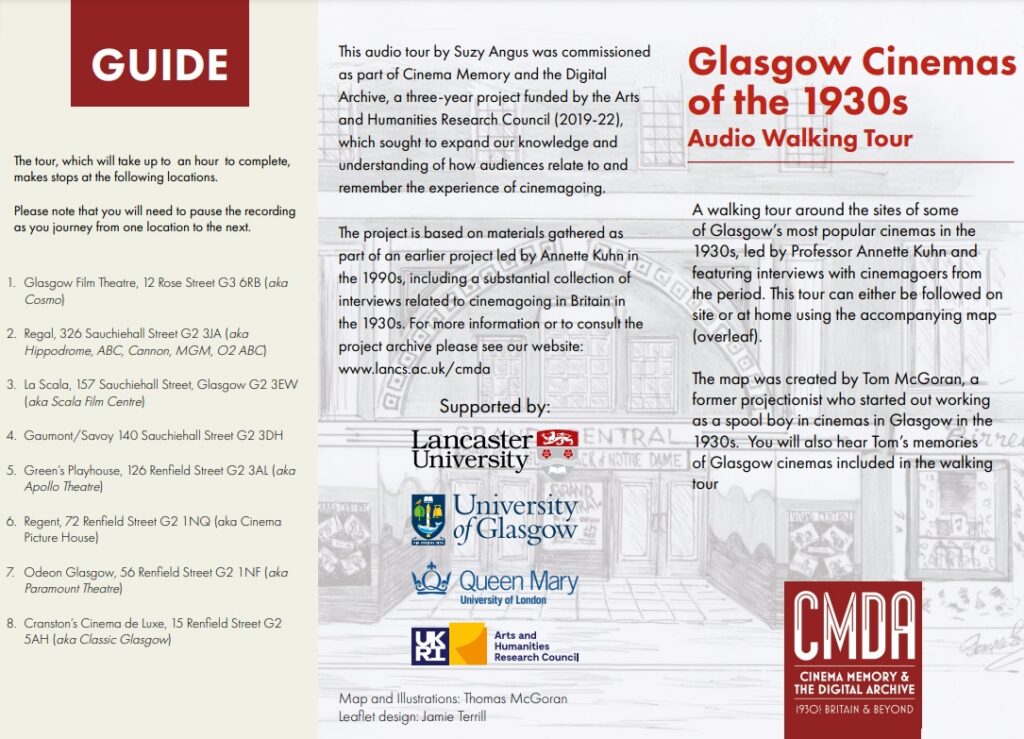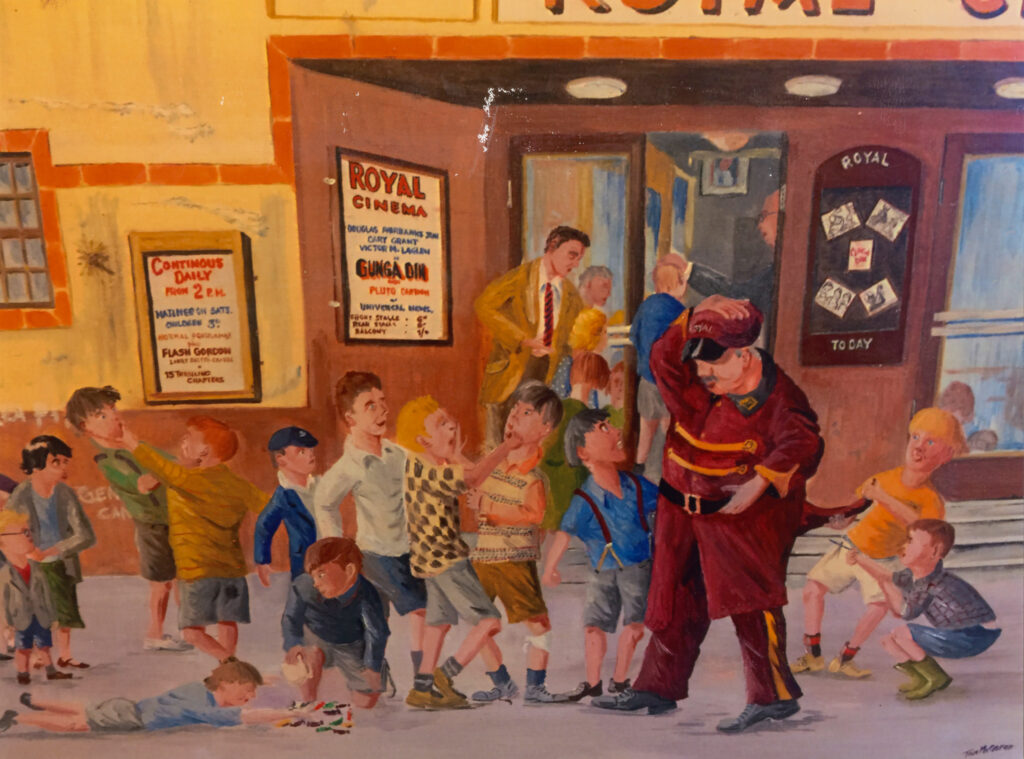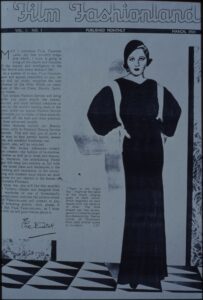
Screenshot of Glasgow Audio Tour leaflet
Audio Walking Tour: Glasgow Cinemas of the 1930s
Please join us on our walking tour around Glasgow. Led by film historian Professor Annette Kuhn and featuring interviews with cinemagoers from the period, we explore the sites of some of most popular cinema in the 1930s. The tours can either be followed on site or at home using the accompanying audio file and map.
Audio tour
Accompanying leaflet (with map)
Audio Features
‘Matinee Specials’ vignette
Matinees were a popular topic of discussion in the CCINTB interviews and was also a key focus of analysis in An Everyday Magic: Cinema and Cultural Memory (London and New York: I. B. Tauris, 2002), Annette Kuhn’s book that arose out of the earlier project. Chapter 3, entitled ‘Jam Jars and Cliffhangers’, looks in detail at the topic:
‘In the matinee, the boy or girl becomes part of the crowd, and with the merging of individual and collective in a children-only space comes temporary freedom from the strictures of the adult world. Significantly, memories of subversions of adult rules, particularly those surrounding admission to cinemas, are similarly discursively organised along collective/repetitive lines. (p. 47)
Memories of visits to matinees in particular emphasise collective audience behaviour as against the informant’s own responses and activities. Stories of children yelling at characters on the screen (‘he’s behind yer!’), booing and cheering, rushing around the auditorium, and using nuts and fruit as missiles abound’.
(pp. 58-9)
In all these accounts, the picture house figures very much as the children’s domain, beyond the writ of adult sanction. And yet while such memories of mayhem are vividly, even gleefully, recounted, their narration often has a detached quality, as if the informant is distancing himself or herself from such bad behaviour.
(p.60)
Penny Matinees
‘Horror Films’ vignette
Horror films also made a lasting impression on many interviewees. Chapter 4 of An Everyday Magic (‘When the Child Looks’), explores the ways in which the recollections of being frightened and frightening films represented a very particular kind of cinema memory and how, for cinema-goers of the interwar period, these memories often had their own ‘distinctive structure of feeling and cultural resonance’ (pp. 66-7).
‘Many interviewees and correspondents offer similar recollections of frightening films […] these accounts are precise in their recollection of the images and scenes which terrified their narrators. So uncommonly vivid and detailed are these stories that it sometimes seems as if, in the process of narrating them, informants are accessing the ‘child’s voice’ within themselves and reliving the experience of being scared out of their wits […] most then disengage from the past and distance themselves from their impressionable younger selves by passing amused judgement (‘It wouldn’t frighten me now’). Laughter is a common accompaniment to these stories.
While being frightened – and enjoying being frightened – by horror stories is a normal, perhaps even a universal, childhood experience, the fears of a generation that grew up in the years between two wars and who spent much of their free time at ‘the pictures’ have a distinctive structure of feeling and cultural dissonance’ (pp. 66-67).
‘Many informants link their memories of 1930s horror films with the recollections of Boris Karloff, who starred in many, including Frankenstein (James Whale, 1931); The Old Dark House (James Whale, 1931); The Mask of Fu Manchu (Charles Brabin, 1932); The Mummy (Karl Freund, 1932); The Bride of Frankenstein (James Whale, 1935); and Son of Frankenstein (Rowland V. Lee, 1939). Some recall that Karloff was a ‘great source for impersonations’ (p. 73).
‘Memory-talk about frightening films […] embodies a highly distinctive mix of contents and discursive registers, typically taking the form of strong anecdotal accounts of isolated scenes or images in films and of narrators’ responses to these. This is in marked contrast with cinema memory in general, in which such vividly detailed anecdotes are most unusual, and it suggests there is something culturally distinctive about the ‘distress and delight’ of cinema terrors.’ (p. 81).
‘Clothes Styles and Dressing Up’ vignette
Fashion was also a popular topic of discussion in the CCINTB interviews. Chapter 5 of An Everyday Magic (‘Growing Up With Cinema’), considers the topic of clothes and dressing-up as part of the general account of the important role cinema played in growing-up.
‘by far the most prominent theme of women’s ‘growing up’ memories is copying the appearance of female stars – usually their hairstyles, sometimes their makeup, occasionally their clothes’ (p. 110).
‘Some informants give accounts of great length involving detailed descriptions of certain styles and how these were achieved, and generally giving the impression that considerable time and effort was devoted to these activities’ (p. 111).
‘Copying film stars’ clothes called for a certain amount of cash, or at least some dressmaking skills, hence perhaps the relatively few memories involving clothes’ (p. 114).
‘The theme of ‘making do’ – making the best of your appearance on limited means – surfaces again and again in women’s stories. Even those who lacked the cash or the skills to try out fashions, hairstyles and makeup could still share their dreams with friends’ (p. 117).
Credits
Sound Design and Post Production
Suzy Angus
Script and Presentation
Professor Annette Kuhn
Interviewer
Valentina Bold
Producer
Sarah Neely
Map Illustration
Thomas McGoran
Leaflet Design
Jamie Terrill
Audio Contributors
“Cosmo”
Anthony (Tony) Paterson
Helen Smeaton
“Regal”
Sheila McWhinnie
“La Scala”
Sheila McWhinnie
Tony Paterson
Thomas McGoran
“Green’s Playhouse”
Thomas McGoran
Mary McCusker
Tony Paterson
“Regent”
John Fowler
“Odeon”
Helen Smeaton
“Cranstons”
Thomas McGoran
Additional Audio Features
“Matinee Specials”
Mary McCusker
Sheila McWhinnie
Thomas McGoran
“Horror Films”
Mary McCusker
Nancie Miller
Tom Walsh
“Clothes Styles and Dressing Up”
Mary McCusker
Sheila McWhinnie
Sarah Irvine

